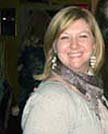"We take care of them, and they take care of us."
~Cindy Judd, Judd Ranch
Last weekend I ventured to my hometown of Pomona, Kansas. Before I took the 300-plus-mile trip there, I arranged a visit to a cattle ranch just a mile down Hwy 68 from my parents' house. Judd Ranch is a seed stock operation where they breed cattle, making them the very beginning of the food chain and a great place to start for anyone who cares to trace the origins of their food. The Judd family is well known in the area for their 700 acres of gorgeous pasture land and their two seasonal auctions: one for bulls and one for females. However, I know the Judds because their oldest son, Nick, was in my grade. In a town as small as Pomona, there is only one class per grade, so you just move from room to room (subject to subject) every hour with the same group of 20 students for over 12 years of your life. So getting to know your classmates is not only easy, it's unavoidable.
The morning I arrived at Judd Ranch I met up with Cindy, the matriarch of the family and my tour guide for the day. It turned out to be an ideal day for a visit; the weather was beautiful, the whole Judd family was working so I got to see everyone, and it was the first day that the herd was re-entering the pasture for the season. Cindy explained to me how their operation worked, including some basic information on cattle breeding, as well as how their cattle are cared for. From March to November, the cattle at Judd Ranch graze on native grasses, and for the other four to five months, when there is no grass on the land to be eaten, they are fed a mixture of grains grown on the same lands owned by Judd Ranch.
The feed is made from a mixture of corn and alfalfa that is fermented on the property. It smells very much like olive tapenade, and the cows absolutely love it!
Since the cows were being turned out on the grass during my visit, we took a rambunctious little cart called a mule out to the many pastures and saw how the cows live for most of the year. It was very nice to see the cows happy and healthy, roaming on bright green grass and playing with their siblings or feeding from their mothers.
We also took a drive through an alfalfa field...
...and stopped to nibble on a bit of it, which tastes a lot like wheat grass juice, if you've tried it, or sort of like snap peas.
Cindy also showed me a watering technique they fashioned, in which they have piped water underground to large overturned tractor tires, so the cows can have access to fresh running water.
However, probably the most valuable thing I learned while I was at Judd Ranch is how eager family farms and ranches are to have people come visit them and learn about the origins of their food. In an industry where factory farms are the norm, and those factory farms are shrouded with secrecy, it is good to know that there are places like this where you can go to personally connect with your food.
If you're in the Pomona area (1 hour from Topeka, 30 minutes from Lawrence, and 1+ hours from the Kansas City area), I highly encourage you to contact Judd Ranch and schedule a tour. You can learn more about Judd Ranch at www.juddranchinc.com or by following them on Facebook.
If you're not in the Pomona area, I also suggest contacting local farms and ranches near you and inquiring about going on a tour. It's both educational and refreshing.
I will now close this post with.....(drumroll)......more pictures of happy cows!!!




















